Article and photos © 2004 by Randy Buckner
November 2004
Part One
The wine press sings the praises of the latest star winemaker and the latest cult wine. However, we read very little about the people that really make it happen - the vineyardists and viticulturists, who grow the vines that produce the grapes.
The old adage about making a silk purse from a sow's ear holds true with wine grapes as well. Great wines come from great grapes, plain and simple. Even the most talented winemaker cannot create a masterpiece from mediocre fruit.
Washington is red-hot in the production of high quality fruit. The long, warm days, cool nights and lengthy growing season insure the grapes reach physiologic ripeness while maintaining high natural acidity.
Certain vineyard sites in Washington have distinguished themselves for their exceptional fruit. Whether this is due to soil type, macroclimate, grape clone or the hand of the viticulturist remains unanswered, but it is most likely all of the above. Let's visit a few of the best vineyard sites in the New World.
 |
| The Chapel of the Vines at Red Willow Vineyards. |
Location
Red Willow Vineyards is part of a larger fourth-generation farm that dates back to the 1920s. This 2200-acre farm grows alfalfa, wheat and Concord grapes (for Welch's grape juice and jelly) in addition to vinifera grapes. Located in the foothills of the Cascade Mountains, specifically on a peninsula of land jutting out from the south-facing Ahtanum Ridge, it is the most northerly and the most westerly vineyard in the Yakima Valley appellation. The entire family operation lies within the Yakima Indian Reservation, 190 miles southeast of Seattle.
Statistics
For those who like stats, here are a few fun facts:
- The vineyards are some of the highest in the state, extending from 1050 feet to 1300 feet in elevation. The highest point in the vineyard is topped by a small Romanesque stone chapel (Chapel of the Vine) that Mike Sauer, vineyardist, built over a three year period from rocks located on the property.
- Portions of the vineyard are as steep as 35 degrees.
- Heat units (h/u) range from 2400 h/u on cooler years to 3000 h/u on really hot years. A "typical" year has 2700 h/u.
- Weather can be harsh. Temperatures range from -7 degrees in the winter to 103 degrees in the summer. Total annual precipitation averages only eight inches. Advantages are the long, warm days, cool nights and the typical 185 day growing season.
- Red Willow Vineyards is named after the local sumac bushes that early settlers called red "willows." They take on a scarlet red coloration.
- The latitude of the vineyards falls roughly between Bordeaux and Burgundy.
- The first grapes were planted in 1971 and the first vinifera grapes followed in 1973.
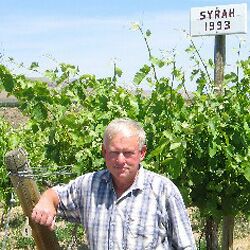 |
| Red Willow vineyardist Mike Sauer |
The land that became Red Willow Vineyards was originally purchased by the Stephenson family in the 1920s, when irrigation canals came to this part of the Yakima Valley. The family spent decades farming the land, growing everything from potatoes and corn, to wheat and alfalfa. Their son-in-law, Mike Sauer, joined the family farming business in 1970 after returning from college. Sauer developed the hillsides on the property into the vineyards they are today. One look at the current vineyards will tell you of the dedication and professionalism of Sauer.
Two-thirds of Red Willow Vineyards stood above the repeated Lake Missoula floods at the end of the last ice age, some 12,000 years ago. Those floods deposited silt and sand over the surrounding valley area. The ancient soils in the higher portions of the vineyards missed the flooding. They are well-drained and nutritionally poor, which provides ideal conditions for vinifera grapes.
The vineyard sections are all hand pruned, with extensive canopy management being the norm. The only grapes that are machine picked are Gewurztraminer and Riesling. The vineyards are turning to totally sustainable agriculture. They have a huge composting program that produces 600 tons a year! This compost is spread under the trunks of the vines every three years.
New plantings continued over the years, but it has been tough work. Sauer stated it took ten days on a bulldozer just to develop one acre of Viognier. Acreage expansion has now ceased. They have now turned their attention to finding the best clones for the site. Many existing grapes will be replaced by better clonal selections from their test blocks.
Sauer, like all savvy vineyardists, has a deep connection with the land. He understands the differences in the various soil types found in the vineyard - for instance the upper one-third of the land has sandstone found not found in the lower levels. He has kept an open mind and realizes that some early plantings that he made were not the right choice for the land. He continues to try out new grape varieties and clones. Sauer believes that it will take at least another generation of trial and error experimentation to find the ideal match of vines to the land and macroclimate.
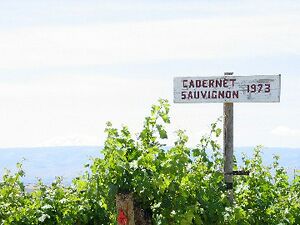 |
| Cabernet Sauvignon vines at Red Willow Vineyard. |
Red Willow Vineyards first planted Cabernet Sauvignon in 1973, a grand total of three acres. In 1978 they developed a long-term relationship with Columbia Winery (then known as Associated Vintners). David Lake was hired the next year as winemaker for Columbia Winery. In 1981 Lake chose to release the first vineyard-designated wine from the vineyard, the Red Willow Cabernet Sauvignon, which continues to this day. One of the longest relationships of vineyardist and wine maker is between Mike Sauer and David Lake, and their mutual respect for each other's skills shows.
With the release of the Red Willow Syrah in 1988, Columbia Winery produced the first Syrah in the Pacific Northwest. Year in and year out, this continues to be my favorite wine sporting the Red Willow designation. A vertical tasting of the wines shows their staying power over the years.
Other grapes found at Red Willow Vineyards are Merlot, Cabernet Franc, Sangiovese, Malbec, Gewurztraminer, Riesling, and Viognier. Based on my personal observations, the latter shows great potential at the Red Willow site. Maybe we can twist Sauer's arm to plant more! Columbia Winery receives 97 percent of the Red Willow grapes, with 3 percent going to Cavatappi and Yakima Cellars.
Mike Sauer is not the type of man who seeks the limelight. He is a farmer and a vineyardist with a strong work ethic and an ever questioning mind. Look for great things to continue to happen at Red Willow Vineyards.
The Wines
Following are my notes on six wines carrying the Red Willow Vineyard designation.
1999 Columbia Winery, Cabernet Sauvignon, Red Willow Vineyard, Yakima Valley, Washington, $25, 2,514 cases. Blackberries, blueberries, cedar, vanilla, and violets intermingle on the nose and carry over to the mouth. The wine is full bodied with moderate tannins that need a few years of patient aging; 89+/89+.
1999 Columbia Winery, Milestone Merlot, Red Willow Vineyard, Yakima Valley, Washington, $27, 3,058 cases. Black cherry fruit, vanilla, and violets caress the nose. The bold, rounded tannins need bottle aging. Crisp acids add zip to the earthy black fruit; 88/88.
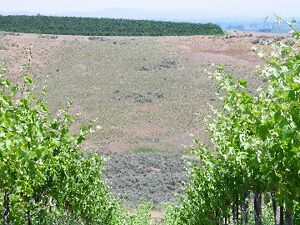 |
| Red Willow's vineyards were carved from sagebrush-covered land. |
2000 Columbia Winery, Syrah, Red Willow Vineyard, Yakima Valley, Washington, $35, 2,600 cases. Year in and year out this is the best wine in Columbia's portfolio in my opinion. Presented in a very polished style, the wine is packed with aromas and flavors of blackberries, blueberries, white pepper and smoke. The finish seems endless; 92/92.
2003 Columbia Winery, Viognier, Red Willow Vineyard, Yakima, Washington, $30. Very floral with white peach aromas that carry over to the mouth. The wine only sees old oak barrels with at least seven years of age to them, which gives the wine roundness without overt oakiness. A dandy wine; 91/91.
1998 Peninsula, Red Wine, The Pride of Red Willow Vineyard, Yakima Valley, Washington, $65, 1,090 cases. Black fruit, spices, and floral notes are displayed across the board. The wine has flawless balance, with a lush, crisp mouth feel and good oak integration; 90/88.
Boushey Vineyards
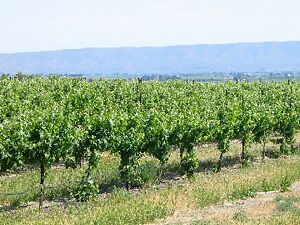 |
| Boushey Vineyards. |
Boushey Vineyards is composed of four separate vineyard sites, all located within a mile and a half of each other, close to the town of Grandview, in the mid-Yakima Valley. Owned and operated by one of the most personable and dedicated persons in the industry, Dick Boushey (like all great growers) never settles for status quo. He is one of the state's most experienced growers, serving for years as a leader in Washington's budding wine industry. He is always striving to find that perfect grape clone to match that exact spot where the magic all comes together.
The Vineyards
Like many other farming operations in Washington, Boushey is diversified to keep his equipment and employees busy. Besides vinifera grapes, he grows apples and cherries for market, as well as Concord and Niagara grapes for juice, jelly and jam. He planted his first grapes in 1976 as an experiment and the rest is history.
Boushey's vineyard sites (formerly planted to apples, nectarines, peaches and cherries) are located in a relatively cool area of the valley at 900-1200 feet in elevation. He states his fruit ripens about two to three weeks later than the grapes on Red Mountain (which is located at the far eastern end of the Yakima Valley). This long hang time allows the resulting wines to obtain great character and depth.
Riding in his truck to the various vineyard sites, Boushey explained the factors he considers essential in his vineyard site selections. It quickly became apparent that he understands the land and its macroclimate well.
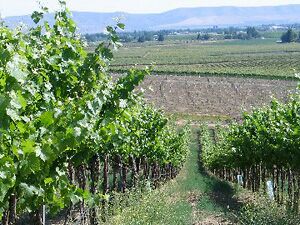 |
| Grande Côte section of Boushey Vineyards. |
Bob Betz, M.W., declares "And we love Dick's Syrahs: all three of them! We source this variety from three different Boushey vineyards, each having its own characteristic aroma and flavor. To determine the wine differences we ferment all three lots exactly the same and age them in a similar mix of small French barrels. While the three vineyards show their own traits, each is blessed with enormous fruit, spice and lengthy finish. We typically find that the three vineyards blended make the most complete and characterful wine. Our 2000 Syrah La Serenne, made entirely from Dick's grapes, was voted one of the 'Ten Best American Syrahs of 2003' by Wine & Spirits magazine."
The Grapes
Cabernet Sauvignon, Syrah and Merlot are the mainstays of Boushey Vineyards. Merlot used to be his darling grape to grow but now he admits that Syrah has stolen his heart. Boushey believes (and I strongly agree) that Washington State is where the future lies for Rhone grape varieties in the new World. He has recently planted Cinsaut, Grenache Blanc, Marsanne and Roussanne vines. Boushey also has Cabernet Franc and Sangiovese in the ground, claiming the latter is the most challenging grape to grow due to the large clusters and vigorous foliage.
The Wines
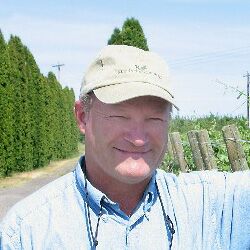 |
| Dick Boushey with his everpresent smile. |
He sells grapes to several wineries, including Baer, Betz Family, Chinook, DeLille, Forgeron, Long Shadows, McCrea, Three Rivers, Widgeon Hill and Wine Glass. Of these wineries, C.R. Sandidge, McCrea Cellars and Three Rivers Winery make vineyard-designated wines. The Betz Syrah La Serenne, while not specifically vineyard-designated, contains 100% Boushey fruit.
2002 Betz, Syrah, La Serenne, Yakima Valley, Washington, $40, 204 cases. There's no reading print through this one. Very aromatic, this wine is all about power and grace. Rich, juicy plums and black raspberries carry from the nose to the palate, riding on a backbone of silky tannins, balancing acidity, and very well-integrated oak. The blueberry finish lingers for some time; 92/92.
2001 McCrea Cellars, Syrah, Boushey Grande Côte Vineyard, Yakima Valley, Washington, $42. This one is not for the faint of heart. This is your no-holds-barred, blow your hair back, silicone implants Syrah. Very intense on the nose and in the mouth, the black fruit, blueberries and smoky notes are quite complex. The finish lingers endlessly; 93/93.
2002 McCrea Cellars, Syrah, Boushey Grande Côte Vineyard, Yakima Valley, Washington, $44. Ruby with blue overtones. Smoky black fruit, game, and mocha dominates the nose. Almost liqueur-like in the mouth, McCrea always seems to hit the "sweet spot" with his alcohol levels. This is a big boy, with lush dark berry fruit, milk chocolate and silky tannins; 91/91.
2001 C.R. Sandidge, Syrah, Boushey Vineyard, Yakima Valley, Washington, $28. Aromas of blackberries, smoky cedar and licorice leap from the glass. Very crisp and lean in the mouth, the wine unfolds in layers of plum preserves, black cherries, warm spices and obvious barrel notes; 86/86.
2001 Three Rivers Winery, Syrah, Boushey Vineyards, Yakima Valley, Washington, $39. I had to look twice to make sure that I did not pour out the inkwell. The color is as intense as the aromas and flavors. Loaded with notes of black fruit, dewberries, dark chocolate, smoked game and sweet oak, the wine manages to maintain a nice overall sense of balance; 91/91.




